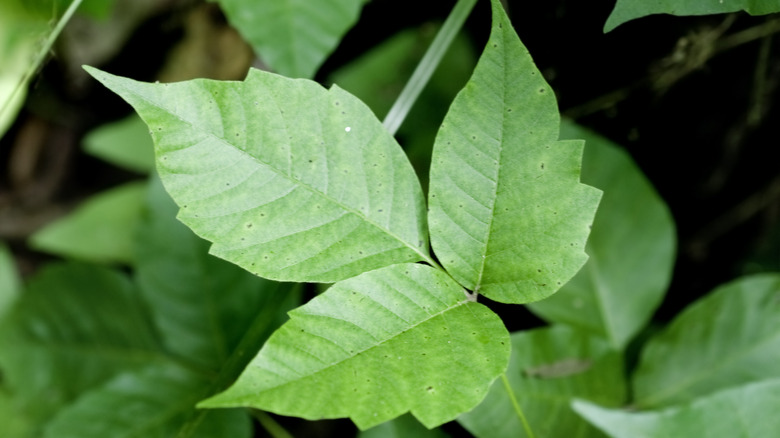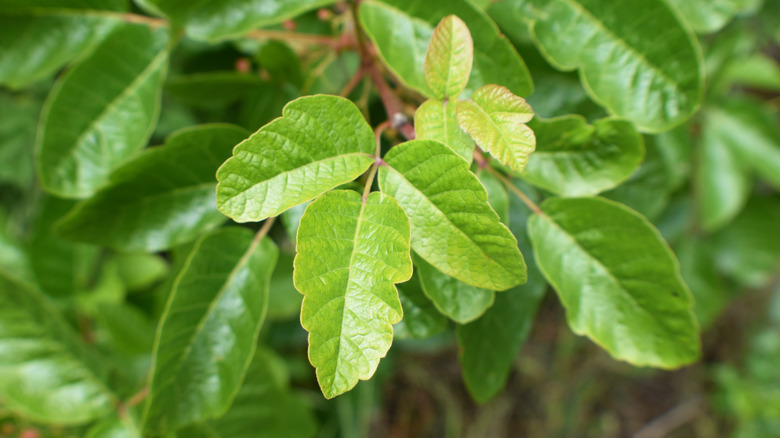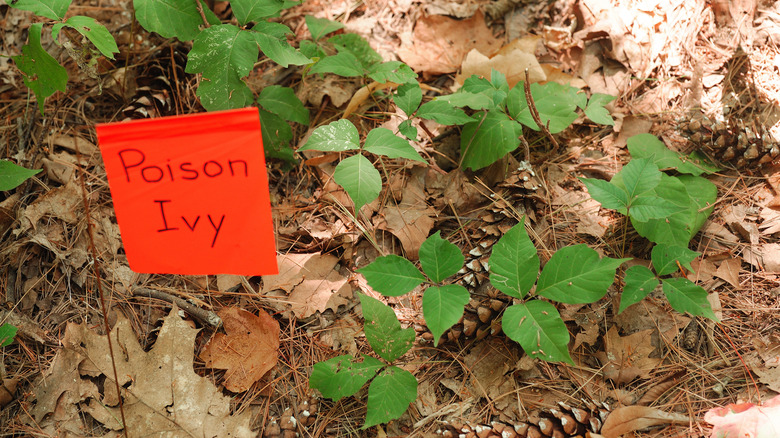Poison Ivy Vs. Poison Oak: What's The Difference?
Nothing can make you feel quite as miserable as having an itchy and painful rash from poison ivy or poison oak. These two plants tend to look quite innocent (if you don't know what they are) and it's easy to unknowingly brush up against them only to experience the painful effects later on. The reason for this reaction is that both plants contain the same oil — called urushiol — which around 85% of people worldwide are allergic to. This means that touching either of these plants produces the same reaction, and it's almost impossible to tell the difference between a rash caused by poison ivy or poison oak, per the Cleveland Clinic.
So, if the reactions are the same, why should you worry about the differences between the two plants? Well, firstly it's important to be able to recognize both plants in order to avoid them. Plus, poison ivy and poison oak are more likely to grow in different areas of the U.S. and are even typically found in different parts of the forest. Knowing these differences can help you better prepare for your next outdoor adventure and avoid the uncomfortable side effects of accidentally touching poison ivy or oak.
It's all in the leaves
The easiest way to tell poison ivy and poison oak apart from each other (and from other plants) is in the shape and grouping of the leaves. You've probably heard the phrase, "Leaves of three, let it be," which is a rhyme meant to help us remember that poison ivy often grows in groups of three leaves all joined together at the stem. Poison oak also typically grows in leaves of three, but the tricky thing with poison oak is that it may also grow in larger leaf groups of four or more.
If you aren't sure if the plant you touched is poison ivy, oak, or something else then you can always look at the shape and appearance of the leaves. Poison ivy leaves are glossy in texture. They have sharp edges and a mitten-like shape because the middle lobe of the leaf is longer than the others. Furthermore, poison ivy often has a red spot where all three stems of the leaves join. Compared to poison ivy, poison oak doesn't have sharp lobes but rounded ones — more like the leaf of an oak tree. Poison oak leaves are also not smooth in texture and are fuzzy underneath.
It is also important to note that poison ivy and oak are not always green. The color of poison ivy changes from yellow to green to red depending on the season. Poison oak can also turn red or brown in the fall.
Where to look for poison ivy and oak
Poison ivy and poison oak grow almost all over the contiguous United States, however, you are more likely to find one over the other in certain areas of the country. Poison ivy grows in every US state except for California, Alaska, and Hawaii. On the other hand, poison oak tends to grow in the Southeastern and Western U.S. Areas in which you are less likely to find poison oak include the Northeast, the Midwest (except for Illinois, Missouri, and Kansas, where it is common), and the mountain time states (including Arizona, Utah, New Mexico, Colorado, Wyoming, Idaho, and Montana).
Another aspect to pay attention to when it comes to poison ivy and oak is that they like to grow in different areas. Poison ivy prefers to grow near water and enjoys growing in forests and yards. Poison oak prefers drier areas and is often found in pine and oak forests. It's also important to know that both poison oak and ivy can grow in the form of woody vines that climb up trees and buildings. So, before you grab and yank on that innocent-looking brown vine, make sure that the leaves attached to it aren't in groups of three!


